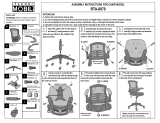4 5
930300 Rev. C 930300 Rev. C
II. TABLE OF CONTENTS
1I. TABLE OF CONTENTS
1. INTRODUCTION .............................................................................. 3
a. Sunrise Listens ...................................................................................... 3
11. TABLE OF CONTENTS .................................................................. 4
III. YOUR CHAIR AND ITS PARTS ................................................ 6
IV. NOTICE - READ BEFORE USE .................................................. 12
V. GENERAL WARNINGS.................................................................... 13
a. Weight Limit ........................................................................................ 13
b. Weight Training .................................................................................... 13
c. Getting to Know Your Chair ............................................................ 13
d. To Reduce The Risk of an Accident ................................................ 13
e. Safety Checklist .................................................................................. 14
f. Changes & Adjustments .................................................................... 14
g. Environmental Conditions ................................................................ 14
h. Terrain .................................................................................................... 15
i. Street Use ............................................................................................ 15
j. Motor Vehicle Safety .......................................................................... 15
k. When You Need Help ........................................................................ 16
VI. WARNINGS: FALLS & TIP-OVERS .......................................... 17
a. Center of Balance .............................................................................. 17
b. Dressing or Changing Clothes ........................................................ 17
c. Wheelies .............................................................................................. 18
d. Obstacles .............................................................................................. 18
e. Reaching or Leaning .......................................................................... 19
f. Moving Backward ................................................................................ 20
g. Ramps, Slopes & Side Hills ................................................................ 20
h. Transfers ................................................................................................ 21
i. Curbs & Steps ...................................................................................... 22
j. Stairs ...................................................................................................... 22
k. Escalators .............................................................................................. 22
VII. WARNINGS: FOR SAFE USE ...................................................... 23
a. Learning to do a “Wheelie” ............................................................ 23
b. Descending a Curb or Single Step .................................................. 23
c. Climbing a Curb or Single Step ...................................................... 24
d. Climbing Stairs .................................................................................... 24
e. Descending Stairs ................................................................................ 24
f. Maintenance .......................................................................................... 25
VIII. WARNINGS: COMPONENTS & OPTIONS ........................ 26
a. Anti-Tip Tubes ...................................................................................... 26
b. Armrests .............................................................................................. 26
c. Cushion & Sling Seats ........................................................................ 26
d. Fasteners .............................................................................................. 27
e. Footrests ................................................................................................ 27
f. Pneumatic Tires .................................................................................. 27
g. Positioning Belts .................................................................................. 28
h. Power Drive ........................................................................................ 28
i. Push Handles ........................................................................................ 28
j. Quick-Release Axles .......................................................................... 29
k. Rear Axles ............................................................................................ 29
l. Rear Wheel Locks .............................................................................. 29
m.Modified Seat Systems ...................................................................... 30
n. Upholstery Fabric .............................................................................. 30
IX. CHAIR BASICS .................................................................................. 31
a. To Mount & Remove Rear Wheels ................................................ 31
a. To Fold & Unfold Chair .................................................................... 32
X. SET-UP AND ADJUSTMENTS .................................................... 33
a. Set-up .................................................................................................... 33
b. Tools ...................................................................................................... 33
c. To Find and Correct a Problem........................................................ 34
d. Anti-Tip Tubes ...................................................................................... 34
e. Standard & Low Front Seat Heights .............................................. 36
f. Caster Forks ........................................................................................ 37
g. Axle-Plate Adjustable ........................................................................ 37
h. Toe-in and Toe-out .............................................................................. 37
i. Rear Wheels - Threaded or Fixed Offset Axles .......................... 38
j. Rear Wheel Locks .............................................................................. 38
k. Flip-Back Armrests .............................................................................. 38
l. Flip-Back Height Adjustable Armrests ............................................ 39
m.Swing-Away Hangers & Footrests ................................................ 30
n. Articulating Legrest & Elevating Legrest ...................................... 41
o. Caster Plates ...................................................................................... 41
p. Caster Mounting ................................................................................ 42
q. Backrest .............................................................................................. 42
XI. TROUBLESHOOTING .................................................................... 44
X11. MAINTENANCE ................................................................................ 45
XIII. SUNRISE LIMITED WARRANTY .............................................. 47






















